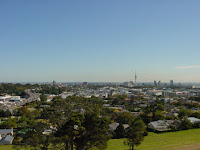In this post and ones to follow, I want to look at the Auckland Unitary Plan: Its implications for Auckland and the planning issues that it raises.

First up a declaration of interest. I'm not a disinterested observer. I helped prepare parts of the Plan and presented evidence to the Independent Hearings Panel that considered submissions on the proposed Unitary Plan. No doubt I will be involved in applying the plan in the future. I'm also an Auckland resident.
To start with, lets look at the big picture. The Plan provides the space needed for 400,000 dwellings. This is apparently enough for the next 30 years. What is not totally clear is that as far as I can tell, the Plan actually provides capacity for up to 1.5 million dwellings.
The difference is between what is called plan enabled capacity (an estimate of the physical capacity enabled the various zonings), and feasible capacity which is based on modelling of what may be feasible for a developer to build. Based on the reports provided by the Panel, I have found the following figures:
| Area | Plan enabled | Feasible |
| Residential zones | 970,554 | 185,339 |
| Business zones | 347,147 | 84,732 |
| Greenfield areas | 181,770 | 138,117 |
| Rural areas | ; 14,220 | 14,220 |
| Total | 1,513,691 | 422,408 |
Having lots of capacity is not a bad thing. What the numbers do raise is a number of planning issues that I want to look at:
The feasible development potential of the residential zones is estimated to be about 20% of the physical capacity. This is obviously a big assumption. To get one house built, do we always need space for five?
Is a 30 year time frame too long? Can we really predict growth demands that far ahead? In the past plans looked out 20 years - the first 10 years covered the legal life of the plan, while the next 10 years provided a buffer. The shift to a 30 year time frame is a new move.Is it appropriate given the difficulties of predicting future conditions?
The Plan says that there should always been at least 7 years supply of development opportunities 'ready to go'. The Plan has provided 30 years supply, so do we not need to do any more planning for the next 23 years?
If the actual objective is enabling more competitive land and development markets so as to moderate house price increases, then is it more a matter of keeping a large pool of possible development opportunities on the go so that there are many more choices for developers, rather than just capacity?
The estimate of feasible capacity is based on a model using current data about property prices and costs of development. Is it reasonable to use that model to identify feasible capacity 30 years ahead?
Is the model used robust enough to justify so much weight on needing to find sufficient feasible capacity? Has the model been validated by applying to previous growth patterns? How does the model address changes in land values that inevitably follow changes in zoning?
So lots to think about. In the next post I want to look at the geographic spread of the plan enabled and feasible development capacity proposed by the Plan.